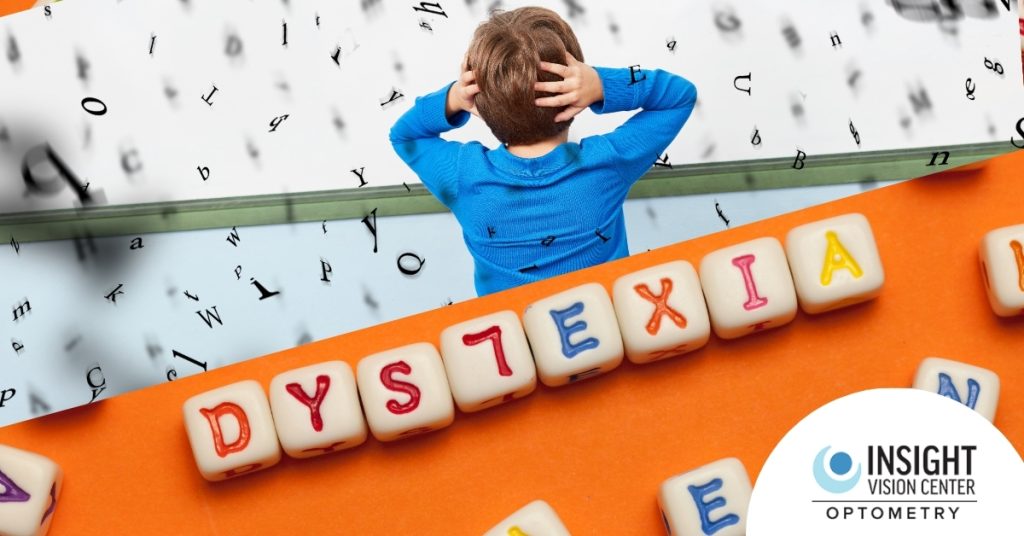While dyslexia is not a vision condition, nor treated by eye doctors, the connection between them is critical for parents, educators, and healthcare professionals to understand.
What is the relationship between dyslexia and vision?
Dyslexia and vision deficiencies display many of the same symptoms. Furthermore dyslexic kids are far more likely to also have a vision deficit.
- 62% of children diagnosed with dyslexia also have eye tracking disorders.
- 79% of children struggling with reading also face problems in binocular/vergence control according to studies conducted by Harvard Medical School and Boston Children’s Hospital.
A developmental eye exam will many times show that the underlying issue is vision related, or that in addition to dyslexia there is a vision problem that is making it even more difficult.

Co-Occurring Vision Issues and Dyslexia
Statistics show a concerning overlap between dyslexia and vision problems:
- Approximately 62% of children diagnosed with dyslexia also have eye tracking disorders.
- Common symptoms of both conditions include headaches, fatigue while reading, difficulty maintaining attention, and confusion with similar letters (e.g., “b” and “d”).
- Many eye conditions can present similarly to dyslexia, with 13 out of 17 symptoms of dyslexia also associated with vision disorders.
Overlap of Symptoms and Ruling Out Vision Issues
Common symptoms of both dyslexia and vision-related learning disorders include:
- Slow or labored reading
- Frequent re-reading of sentences
- Skipping or repeating lines or words while reading
- Eye strain or discomfort, especially during close work
- Difficulty with spatial awareness, such as consistently confusing letters like “b” and “d”
- Headaches with near work or reading
Due to these overlapping symptoms and frequency of dyslexic kids also having vision deficits, it is vital to schedule a developmental eye exam.
Role of the Visual System in Reading
Reading is a complex skill that involves much more than simply recognizing letters and words. Effective reading requires the seamless integration of multiple visual processes, including eye movement control, visual processing, and the ability to decode and interpret text. For children, this means that a well-functioning visual system is integral to academic success.
For instance:
- Visual Efficiency: Children need to use their eyes effectively to track text smoothly and comprehend the material. Poor eye teaming can prevent proper alignment and focus.
- Visual Processing Skills: If a child’s brain struggles to interpret visual information, they may be unable to recognize letters and words quickly, which is essential for fluent reading.
- Visual-Motor Integration: The ability to coordinate visual input with motor actions is vital for writing and other school tasks. Challenges in this area can hinder a child’s performance across academic subjects.
Dyslexia & Developmental Vision Deficits
How Common is Dyslexia
- Dyslexia is one of the most common learning disabilities, affecting about 1 in 8 students in the classroom.
- Fewer than 1 in 10 children with dyslexia are formally diagnosed.
How Common are Developmental Vision Issues in Kids?
- Multiple studies show that 6% and 16% of children may have eye tracking/movement or binocular vision deficits based on multiple studies.
- Binocular vision dysfunction are estimated to impact 1 in 5 school aged children
- Convergence Insufficiency 4%-8%
- Amblyopia 1%-2%
- Strabismus 2%-3%
- Convergence excess 5%-7%
- Phoria 10%
How Common are Developmental Vision Issues Among Children With Learning or Behavioral Issues?
- Over 50% of children with dyslexia have eye movement dysfunction according to a 2021 meta analysis.
- Research from Harvard Medical School showed that 79% of children who struggle with reading also face problems in binocular/vergence control.
- Studies showed that children with ADHD were three times more likely to have binocular vision issues.
- 18% of kids with learning disabilities have Binocular Vision Issues according to the Mayo Clinic Population Study (2020)
The Importance of a Pediatric Developmental Eye Exam
Differentiating Dyslexia from Vision Disorders
Often, symptoms of dyslexia and vision disorders can overlap, making it crucial to identify if there is also a vision deficit or if the vision deficit is the root cause of the symptoms. It’s important to recognize that while dyslexia is primarily a language-based learning disability, many children with dyslexia also face underlying vision issues that can exacerbate their reading difficulties. A thorough pediatric developmental eye exam can help distinguish whether your child’s challenges stem from a visual processing disorder, which may not be detected in a standard vision screening or eye exam. Symptoms such as skipping words when reading, headaches during near work, or difficulty focusing on printed text can indicate the presence of a vision problem, not just dyslexia.
Difficulties of Diagnosing Dyslexia: The Importance of Ruling Out Underlying Vision Issues
Diagnosing dyslexia is seldom a straightforward task. Researchers and educators alike note that many common symptoms associated with dyslexia—such as slow reading speed, frequent spelling errors, and difficulty comprehending complex texts—can be attributed to significant vision problems that often go unnoticed. It is not unusual for children diagnosed with dyslexia to respond positively when their visual problems are properly treated; this multidisciplinary approach can make a significant difference in your child’s learning journey.
Co-occurrence and Why Fixing Vision Deficits is Beneficial for Dyslexic Kids
Understanding the co-occurrence of dyslexia and vision issues is vital for fostering a successful learning environment. Many children with dyslexia who also experience visual dysfunctions may benefit from vision therapy, which targets the specific visual challenges they face. Even though vision therapy does not treat dyslexia, fixing a child’s visual challenges will normally result in notable improvements in reading fluency and comprehension in dyslexic children with vision problems.
Understanding Dyslexia
Definition of Dyslexia
Dyslexia is a complex learning disability that primarily affects reading, writing, and spelling. This disorder arises from difficulties in processing language and does not reflect a person’s intelligence. Many children with dyslexia face academic challenges, especially since around 80% of learning is visual. A child may struggle with recognizing letters, decoding words, or recalling vocabulary, leading to frustration and low self-esteem.
Common Misconceptions
One prevalent myth is that dyslexia is simply a result of poor teaching or lack of effort. It’s essential to understand that dyslexia is a neurobiological condition—it is not inherently tied to a low IQ. Misunderstandings surrounding dyslexia can either vilify the child or foster negative self-perceptions. Many parents and educators may be unaware that even children with 20/20 vision can experience severe visual processing issues, which may contribute to their dyslexia symptoms. Therefore, vision disorders can mimic or exacerbate dyslexia, making it crucial to explore all potential underlying causes.
Dyslexia as a Language-Based Learning Disability
Dyslexia is characterized as a language-based learning disability that refers to a cluster of symptoms leading to difficulties in specific language skills, particularly reading. This intricate condition often coexists with visual processing issues. Studies have shown overlapping symptoms between dyslexia and visual disorders, making it challenging for parents and educators to distinguish between the two.
Common indicators include:
- Difficulty with phonological awareness, resulting in challenges in learning letter sounds.
- Struggles with rapid word retrieval, leading to slow reading and frequent mispronunciations.
- Signature symptoms such as reversing letters, skipping words, or losing place while reading.
- Physical symptoms like headaches or visual discomfort tied to prolonged reading tasks.
Symptoms of Dyslexia and Signs of Vision-Related Learning Problems
Comparative Look at the Impact on Reading, Writing, and Spelling
Dyslexia is often misconceived solely as a reading disability; it’s a complex condition affecting language processing, impacting not just reading fluency and comprehension but also writing and spelling. While children with dyslexia struggle with accurate and fluent word recognition, their difficulties in reading extend beyond mere phonics. Symptoms can vary widely, from letter reversals, such as confusing “b” and “d,” to challenges in organizing thoughts in writing.
Comparative Symptoms and Indicators to Watch For
Recognizing the symptoms that overlap between dyslexia and vision-related learning disorders is crucial for caregivers and educators. Below is a table detailing the common signs associated with both conditions:
| Signs of Dyslexia | Signs of Vision Issues That Impact Learning |
| Slow and labored reading | Visual discomfort, headaches, or fatigue from reading |
| Difficulty with spelling and frequent spelling errors | Skipping or repeating lines of text while reading |
| Struggle with understanding multi-syllable words | Avoiding reading |
| Difficulty with phonological awareness | Slow reader and poor reading comprehension |
| Poor reading comprehension | Regular headaches or eye strain when reading |
| Avoiding reading tasks | Head tilting or covering one eye while reading |
Multidisciplinary Treatment Strategies
Treating dyslexia often requires a collaborative approach, incorporating various therapeutic avenues to support the child’s learning needs. For many children with dyslexia, underlying visual conditions can impede their reading abilities. Research indicates that children with reading disorders may have co-occurring vision problems, such as eye teaming and tracking difficulties.
- Dyslexia-specific remediation: Phonics-based reading programs that focus on language processing.
- Vision therapy: This therapeutic approach directly addresses visual processing challenges, aiming to improve skills crucial for reading, such as eye tracking, visual memory, and visual-motor integration.
- Tutoring and supplemental education: These interventions can become significantly more effective once foundational visual problems are addressed. Improved visual clarity and comfort can allow children to retain and apply what they learn more successfully.
Role of Vision Therapy
Vision therapy is a personalized therapy that focuses on improving the visual skills needed for effective reading and learning. For many children with dyslexia, the therapy can help enhance visual processing skills and eye coordination.
Research supports the efficacy of vision therapy in improving reading capabilities. Children undergoing this therapy have shown marked improvements in reading fluency and comprehension. Completing a thorough evaluation through a developmental eye exam can ensure children with dyslexia receive the comprehensive treatment they need.
Vision therapy addresses issues like:
- Eye teaming: Enhancing the ability of both eyes to work together effectively.
- Tracking: Improving the eyes’ ability to move smoothly along lines of text.
- Visual processing: Strengthening the skills necessary to interpret and make sense of visual information.
- Visual-Motor Integration: Exercises that develop coordination between visual input and motor output, which can improve handwriting and other written tasks.
- Accommodative and Vergence Therapy: Incorporates lenses, prisms, or other devices to develop focusing skills and eye flexibility.
Outcomes and Benefits
The outcomes of engaging in vision therapy can be both profound and transformative for children grappling with dyslexia. The benefits include:
- Improved Reading Abilities: Many children experience significant enhancements in reading fluency and comprehension, allowing them to achieve grade-level performance.
- Increased Confidence: As children overcome their reading challenges, they often show marked improvements in self-esteem and motivation, leading to a more positive attitude towards learning.
- Better Academic Performance: Enhanced visual skills not only aid in reading but also support performance in other subjects, including mathematics, as these subjects rely heavily on visual perceptual skills.
- Reduced Symptoms of Dyslexia: Vision therapy can alleviate associated symptoms, such as headaches, eye strain, and visual fatigue, making learning less taxing.
- Holistic Support: When combined with traditional dyslexia remediation techniques, such as phonics instruction, vision therapy can make these interventions significantly more effective.
Ultimately, our goal is to ensure that every child has the opportunity to thrive academically and develop a love for learning!






